Utah Governor Gary Herbert announced this week that he’s made good progress negotiating with the federal government on his alternative to Medicaid expansion. The governor says there are still some sticking points in the negotiations – including work requirements for those receiving government assistance. But a new study shows that many of those citizens are already working.
Governor Gary Herbert says he’s going back to DC in June to continue negotiations with the US Secretary of Health and Human Services. Among the items to discuss are how to provide incentives to get people to work and off of government assistance.
“The work requirement is an issue that keeps coming up,” Herbert said at his monthly KUED news conference. “How we do that, and incent people to get off of the government assistance program and on to work is an important part of the issue for me. I think it’s important to the legislature, and I think it’s a concept and a view that most Utahns would support.”
“I think there is a misconception that a lot of these folks don’t work,” says Matt Slonaker, Executive Director of Utah Health Policy Project. In fact,a new study by Families USAfound that a majority of Utahns who would be eligible for coverage under the governor’s Healthy Utah Plan are already working. Using census data, the study looked at those under 138% of the federal poverty level. For a single adult in Utah, that would be about $11,600 a year. Slonaker says there are about 140,000 people in this category.
“The big takeaway is that over two thirds of this demographic are working or have looked for work in the past year,” Slonaker says.
The study found that 66 percent work in low-wage jobs like food service, retail sales, office support, childcare, or construction. Another 18 percent are not considered part of the workforce, including students, family caretakers, and people with medical issues. Slonaker says in general, this population is working hard to try to make ends meet. They simply can’t afford health insurance.







